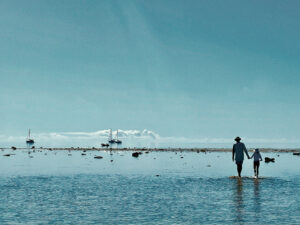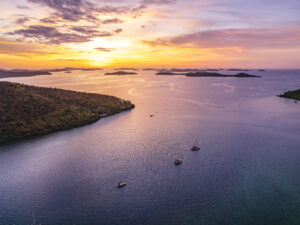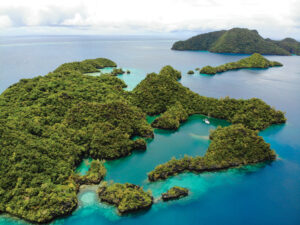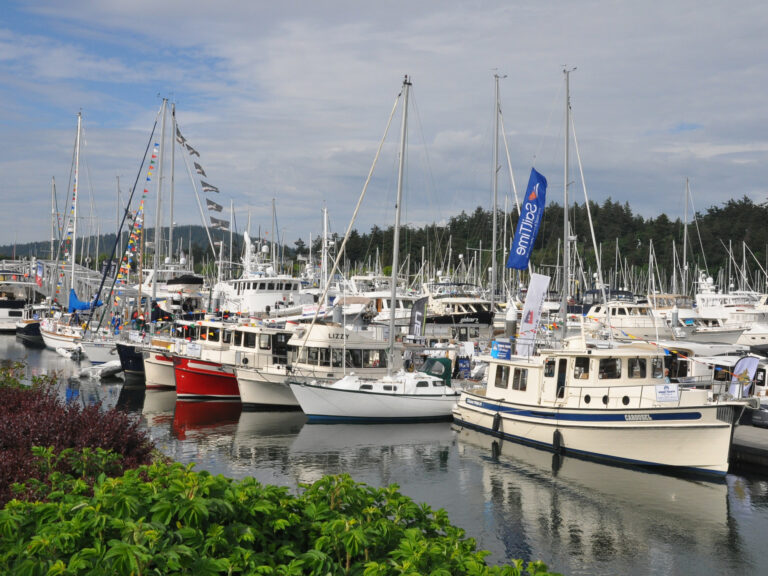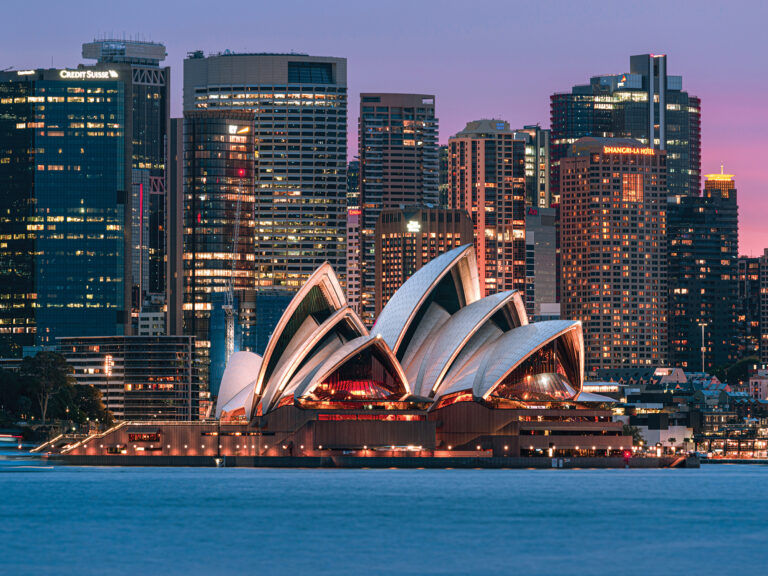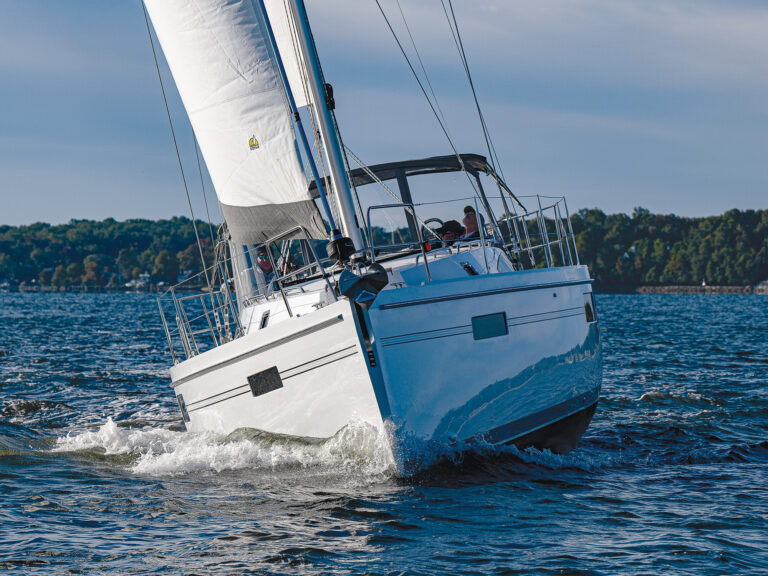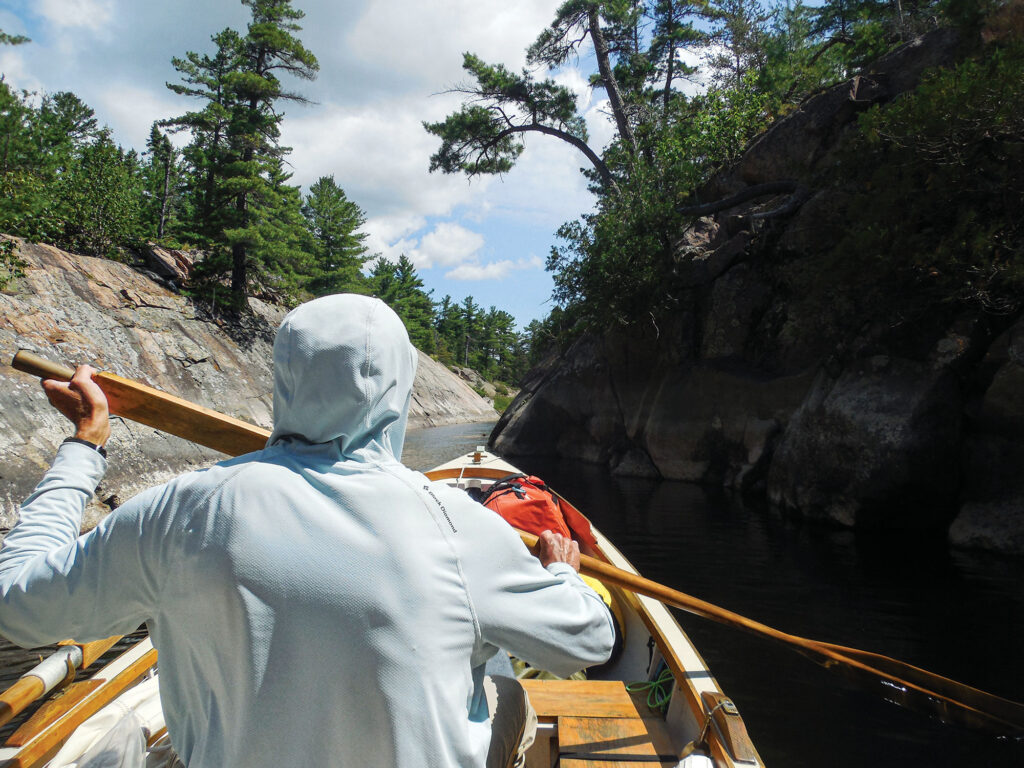
I abandoned keelboats in the 1990s, no longer willing to make the necessary sacrifices. I was tired of slip fees. Tired of haulouts and winter storage. Tired of maintenance. The truth is, I was too lazy for all that, and always had been.
My next boat, FOGG, was an unballasted cruising dinghy hardly bigger than a canoe. I built it with one simple idea in mind: to be able to answer the wind’s call at a moment’s notice. I wanted to hoist the sails and set off for the margins of the map whenever I felt like it, trading long, offshore passages for quiet meanderings along the watery edges of the world.
For my next trip, I planned to take FOGG to the Thirty Thousand Islands, a sprawling Neverland of winding channels, rocky islands and white-pine forests that runs for 120 miles along the eastern shoreline of Lake Huron’s Georgian Bay. For crew, I recruited my friend Jay Williams. An experienced windsurfer but novice sailor, Jay was the only person I knew who’d see a week aboard an open boat as a step upin comfort.
After a 10-hour drive from Wisconsin, we launched the boat in the village of Killarney, Ontario. Jay assembled his gear and loaded the boat as I parked the car and trailer a few blocks away in the back lot at the Church of St. Bonaventure.
Bonaventure. “Good luck.” I hoped we wouldn’t need it.
One advantage of launching at Killarney was the availability of good campsites nearby. With no need to go far on our first night, we treated ourselves to a fried fish dinner at the Herbert Fisheries dockside restaurant before setting off down the narrow Killarney Channel under auxiliary power—oars—in a breezeless calm. Engineless cruising calls for a boat that rows as well as it sails, and FOGG fits the bill perfectly.
A mile out of town, we rowed into Thebo Cove and set up camp on a sweeping granite slab where a low rock ledge formed a convenient dock. We spent a quiet evening under clear skies, the occasional wavering cry of a loon breaking the deep silence, the Milky Way a bright scattering of dust in the night sky.
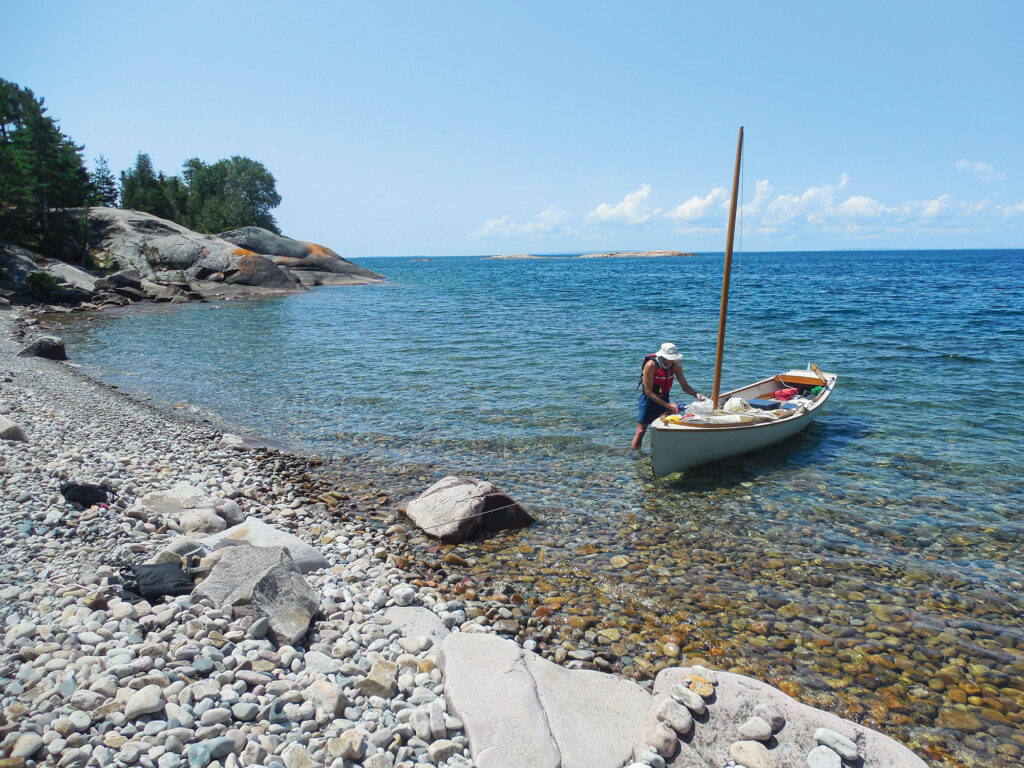
Then next morning, we loaded our gear, rowed past Killarney East Lighthouse into the open water of Georgian Bay, and hoisted the sail. Under blue skies and a moderate breeze, I put Jay at the tiller to get a feel for the boat. He proved to be a quick study.
FOGG’s 85-square-foot boomless standing lugsail involves only a sheet and downhaul, trading sail-shaping controls for simplicity. I’ve come to think of it as a rig that disallows type-A behavior, a perfect match for my own lack of ambition. That said, the rig’s popularity with British and French smugglers in the 17th and 18th centuries suggests a certain level of performance—enough to outrun a revenue cutter, at least. I was more interested in how easy it was to reef the sail, or to strike the rig entirely when necessary, prime virtues for a small-boat cruising rig.
It was still early morning as Jay steered east on a broad reach, one hand on the tiller and the sheet tied off to an oarlock with a slipped half hitch. Perfect sailing. We reached the Fox Islands in a couple of hours, a 6- or 7-mile crossing. With the bow tied to an anchor buried in the cobblestones of West Fox Island’s broad beach, and a smaller anchor off the stern, we waded ashore in knee-deep water. We spent an hour traversing the broad granite summit while the breeze shuffled through the tall white pines overhead and sunlight glittered on the wavetops offshore.
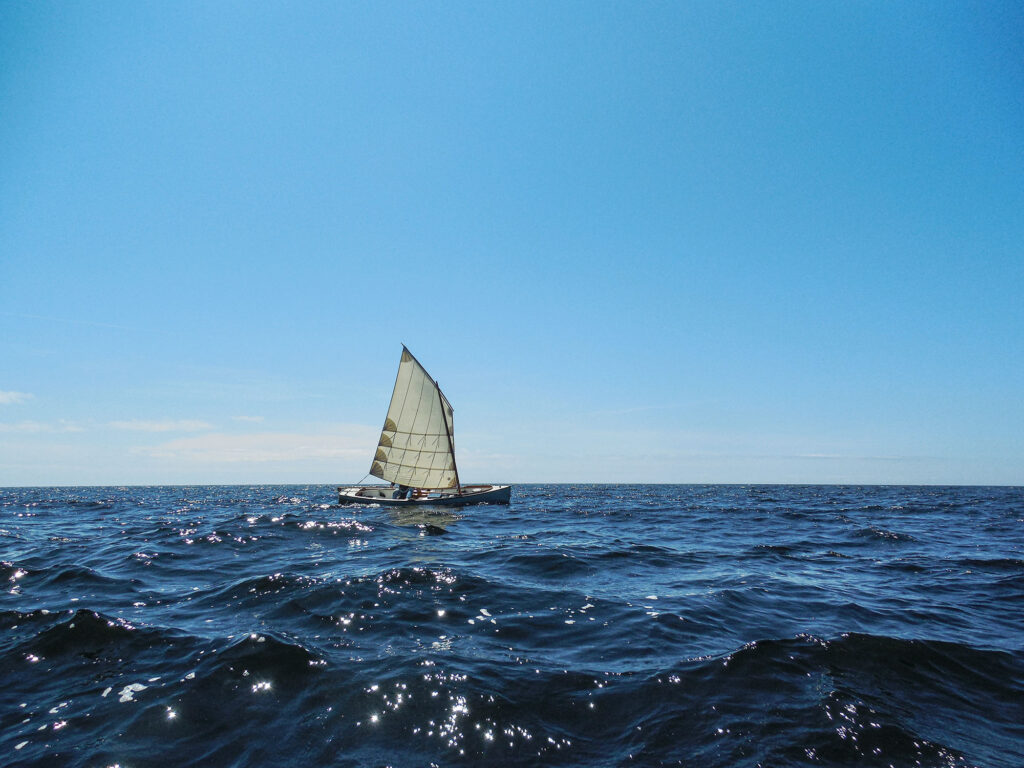
With the wind holding steady from the southwest, I suggested we head for Hawk Island next. It would be a 2-mile hop to a tall granite dome fringed with cliffs and white pines. Jay was proving hard to dislodge from his position at the helm; he was already talking about building a boat for his own sail-and-oar adventures.
I settled in on the forward thwart, arranging a couple of cushions behind me for optimal lounging, and contented myself with an occasional suggestion about sail trim. FOGG surged forward smoothly through the water, its sleek hull moving easily under full sail.
We landed on Hawk Island’s north side, where a rocky arm of the island provided shelter from the southwesterly breeze. The Thirty Thousand Islands region is classic Canadian Shield terrain—a vast region of the north where glaciers scraped the topsoil from the earth as they flowed southward during the last ice age, leaving behind huge expanses of exposed bedrock.
Hawk Island was a perfect example: a slabby dome of granite rising high above the water, all pale-gray stone, clear water and dark pines. We circled the island on foot, scrambling over small cliffs and past deep ravines as a mob of gulls circled overhead, squawking loudly. Other than the gulls, we had it all to ourselves.
By the time we left Hawk Island, the wind had backed to the south. With no goal beyond enjoying the journey, we turned northwest and spent the afternoon threading a winding path through the northern edge of the Fox Islands, ghosting along past island after island in faint breezes, gliding through knee-deep sandy shallows edged by tall reeds, and slipping through rocky channels barely a boatlength wide. The centerboard and rudder touched bottom now and then, dragging through the sand, but we managed to stay afloat. It was a perfect introduction to boathandling for Jay.
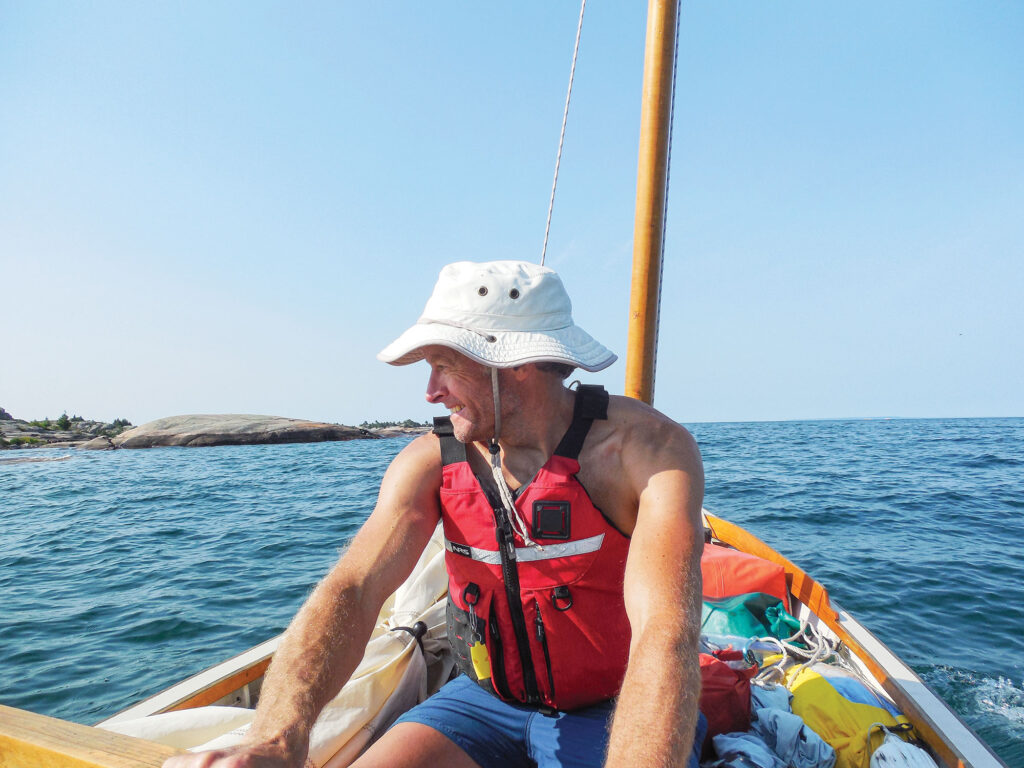
We finally dropped the sail to row through a maze of unnamed rocks toward the north side of Solomons Island, where a broad slab of granite at the water’s edge provided the perfect campsite.
The next morning, I was up before dawn. FOGG hung from the painter just offshore, afloat on a perfect mirror of the world. The water lay as dark and smooth and unruffled as a windowpane, each rock and tree and island reflected in unwavering detail. It was too much to resist.
Leaving Jay asleep in his tent, I shoved off and spent an hour weaving my way through the outlying islands under oars, sneaking through passages barely wider than the boat’s narrow hull. With no roads or cottages nearby, I might have been a thousand miles from anywhere. I returned to camp to find Jay ready for the next leg of the journey, whatever that would be.
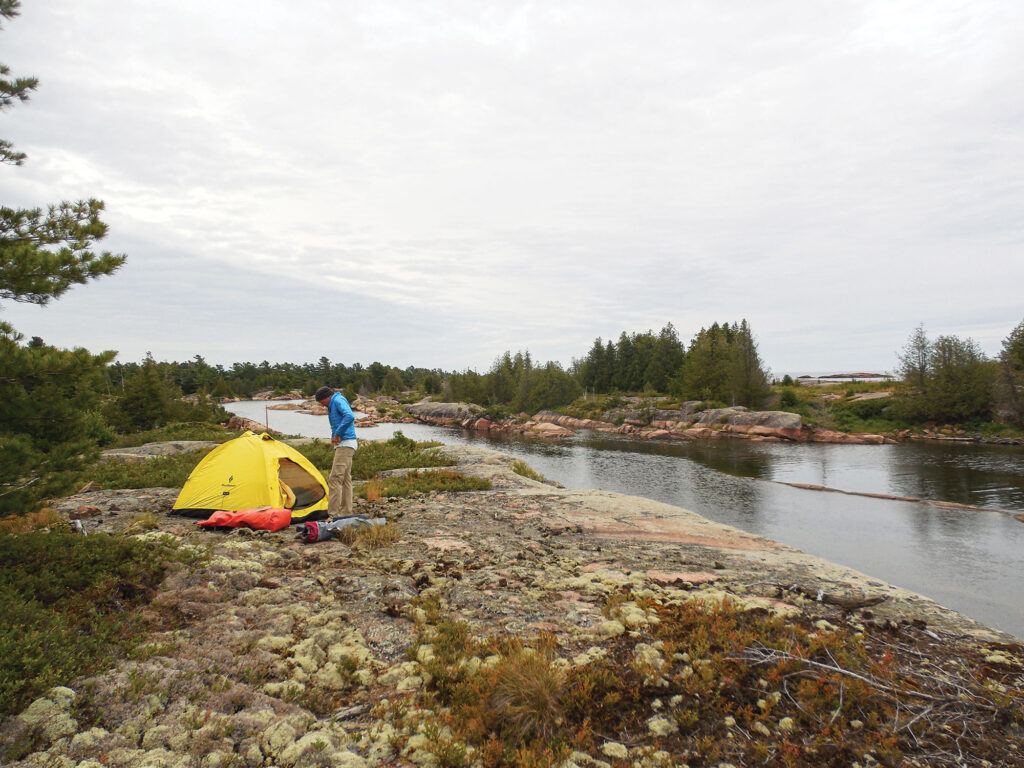
Counting on the prevailing westerlies to continue, I suggested that we set out for the Bustard Islands, about 20 miles east. We loaded the boat, rowed out through the rocks to open water, and hoisted the sail. Knowing that the wind would likely grow stronger as the day went on, I kept a close eye on the conditions as Jay steered us eastward on a southerly breeze.
An hour after setting sail, we had left the Fox Islands behind and were making rapid progress. FOGG’s narrow hull sliced cleanly through the waves on a close reach, but the wind had been building steadily. Whitecaps ruffled the surface in all directions now. The waves were distinctly higher here, out past Hawk Island, with a 60-mile fetch and a strong wind blowing.
Soon enough, the wavetops were higher than our heads, approaching 6 feet from trough to crest—a good reminder of how quickly conditions can change on the Great Lakes. Now and then, a wave crest broke over the side of the boat in a tumbling burst of spray and foam.
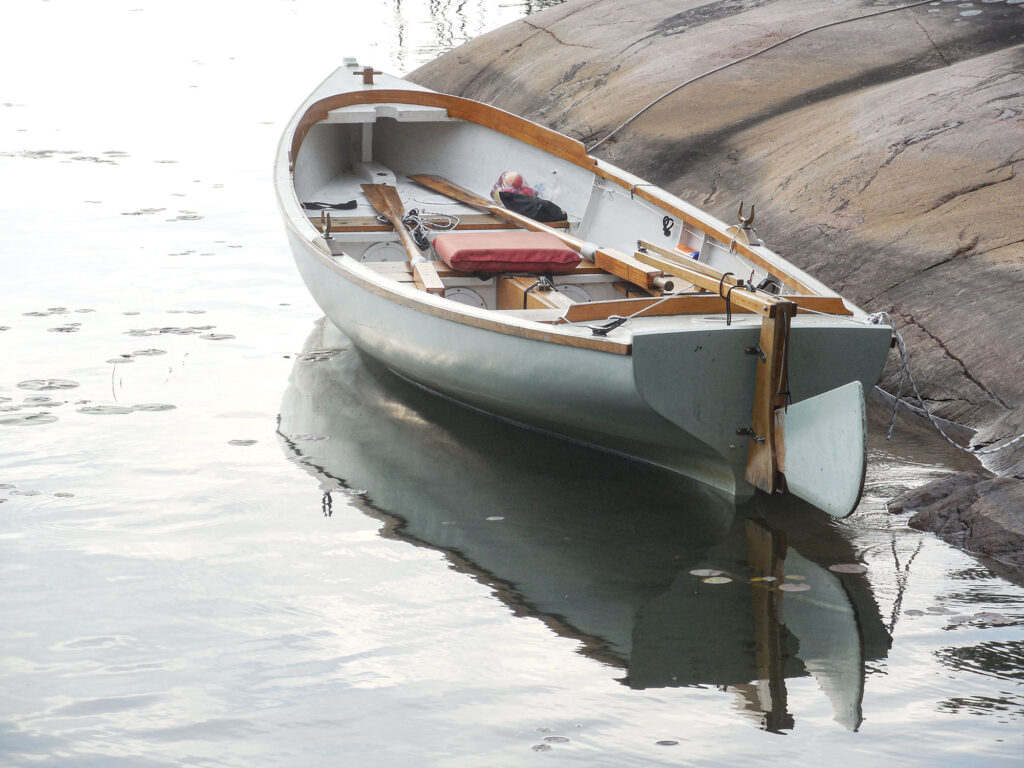
“Is this OK?” Jay asked. “Should we tie in a reef?”
I had been wondering the same thing. FOGG was doing fine for now, covering ground quickly, but these were no conditions for an inexperienced helmsman. It was all too easy to imagine a capsize. I doubted that would prove fatal—I had done extensive capsize testing with FOGG and knew we’d be able to self-rescue if necessary, even in these conditions—but it would make a god-awful mess of things at the very least. And the Bustard Islands were still almost 20 miles off.
“Head us up into the wind,” I told Jay. “We’ll drop the sail and run off under oars.”
Even triple-reefing the sail wouldn’t protect us from the waves, which is why “strike the rig and row” is a time-honored storm tactic for small-boat sailing. Jay turned us directly into the waves, and FOGG coasted to a stop.
Dropping the sail took only a second or two—the weight of the yard brought it down instantly after I uncleated the halyard. Next, I pulled out the mast and laid it in the boat—a simple operation with an unstayed mast only 13 feet long.
Without the sailing rig, FOGG lurched and bobbed in the waves, rolling wildly as the hull was pushed broadside to the swells. I was reminded of a passage from Stephen Crane’s 1897 short story “The Open Boat”: “A seat in this boat was not unlike a seat upon a jumpy horse, and a horse is not muchsmaller.” It was a perfect description of our own situation.
I raised the centerboard and pulled out the oars while Jay steered us toward shore with the tiller. Once we turned off the wind, the boat’s motion steadied down to a mild rolling. Wave after wave passed beneath us, pushing FOGG forward in a surging rush of effortless motion that made my attempts at rowing almost irrelevant. We were just over a mile offshore by my reckoning—30 minutes of downwind rowing, maybe.
The rocky lee shore we were aiming for would have meant disaster for a deep-draft keelboat. For us, it meant safety. FOGG’s 7-inch draft would allow us to slip through the band of rocks and shoals that guards the Georgian Bay mainland to find a protected anchorage in a quiet backwater well inshore. Crisis averted.
After a pleasant night in a perfectly sheltered cove on the southern edge of Philip Edward Island, we set off early the next day. Taking advantage of Georgian Bay’s typical morning calms, we rowed out through a tangle of rocks and shoals amid a chorus of loon calls. A heron flew overhead, wings almost brushing the treetops. Here was the small-boat Neverland we had come for—the north woods shattered into 30,000 pieces, a disassembled jigsaw puzzle scattered across the water all around us.
This was canoe and kayak country, really, but FOGG was proving equally suited to the task, opening the door to a world we never could have reached in a bigger boat.
A mile or two from camp, we arrived at open water just as the wind did the same. I hoisted the sail, and Jay steered southeast on a starboard tack. For this leg of the journey, we’d need to keep well offshore to avoid a long belt of shoals and rocks known as The Chickens, which runs 2 miles from Rooster Rock in the west to Hen Island in the east. The compass bearing that I estimated from a glance at the chart proved accurate enough; Jay soon had the Rooster Rock buoy in sight.
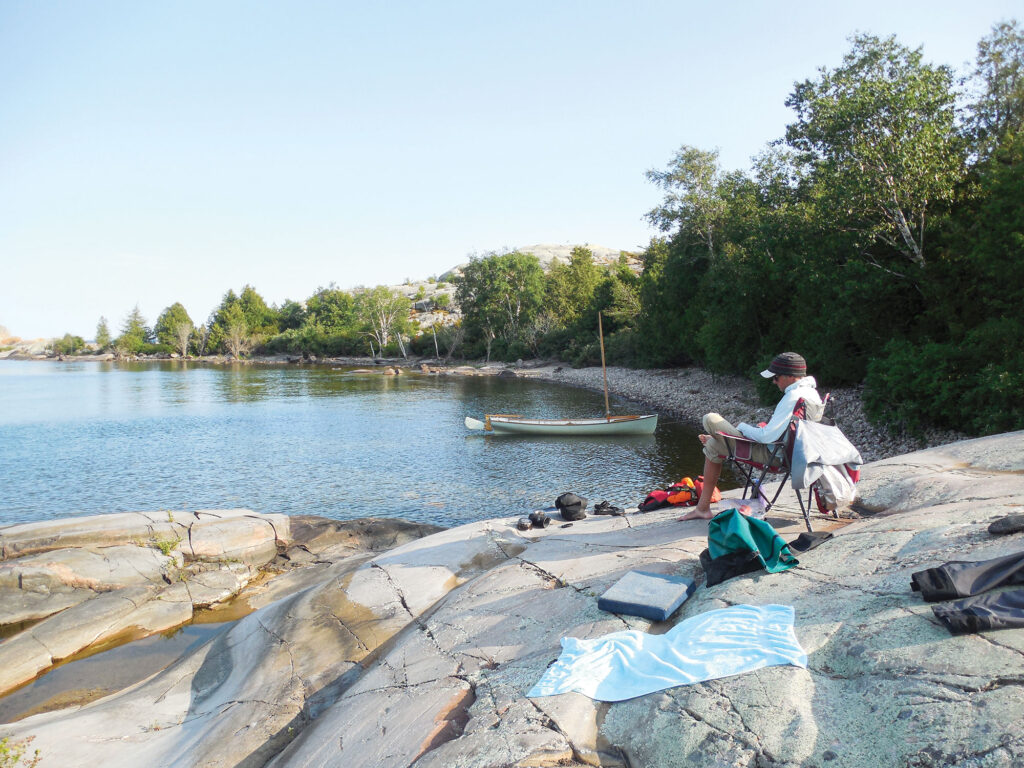
FOGG swept along happily on a close reach, riding easily on waves a foot or two high—an entirely different world from the previous day’s dangerous swells. After a couple of hours, we rounded Rooster Rock and turned due east, on a broad reach now. The day was all blue skies, sun and glittering arcs of spray—perfect conditions—while half a mile to the north, a ragged line of breaking waves and whitecaps marked the edge of The Chickens.
Ten miles farther on, passing Grondine Point (or “grumbling point,” for the continuous rumble of waves on the rocky shore), we decided to take advantage of FOGG’s capabilities by turning north. We would sail up the westernmost channel of the French River Delta through a network of cliff-sided grooves and channels that marked the passage of the glaciers of the last ice age. We’d ride the wind as far as we could, then drop the sail and take to the oars to push farther upriver.
Indigenous peoples have used the sheltered routes through the French River Delta for thousands of years. Later, European fur traders used them too. The path we meant to follow was named the Voyageur Channel. From the chart, it looked like we should be able to sail up this passage for a few miles, turn east along the north side of Green Island, and return to the open waters of Georgian Bay via the Fort Channel a few miles farther east.
The southwest winds pushed us rapidly past long, low ridges that divided the river into an endless series of parallel channels. We were on a broad reach, almost a run, making 4 or 5 knots—too fast for comfort in the narrow, cliff-sided passages. It was time to drop the sail and take to the oars. Five or 6 miles of rowing would take us past Green Island, down the Fort Channel, and back out to open water. By the next day, after overnighting somewhere in the French River Delta, we’d be sailing again. In the meantime, there was no rush.
This was canoe and kayak country, but FOGG was opening the door to a world we never could have reached in a bigger boat.
We spent the rest of the afternoon idling along the Voyageur Channel, trading off stints at the oars and stopping ashore to explore the side canyons, pine forests, and steep granite slabs whenever we found an easy landing place. It was late evening before we finally tethered FOGG to an island at the upper end of the Fort Channel and carried our camping gear up a low-angle slab to a narrow ledge bristling with mosses and lichens: home for the night.
It took three days to work our way back to the car and trailer at Killarney, an as-the-crow-flies distance of 25 miles. But FOGG was no crow. We pushed a few more miles upriver from our campsite the next day, paddling through cliffbound passages that were too narrow for rowing, edging into quiet backwaters lined with lily pads and tall reeds, and tying up beside steep cliffs to climb above the treetops.
We may as well have been alone in the world—we saw no boats, no people. But we weren’t quite alone, either. A black bear shuffled past our campsite in an early-morning fog; a mink slipped along the rocks at the water’s edge as we rowed past; Jay found an Eastern Massasauga rattlesnake curled up in the lichen between our tents. It was the best kind of journey—not sailing, not paddling, not backpacking, but rather a hybrid that combined the best of all of them.
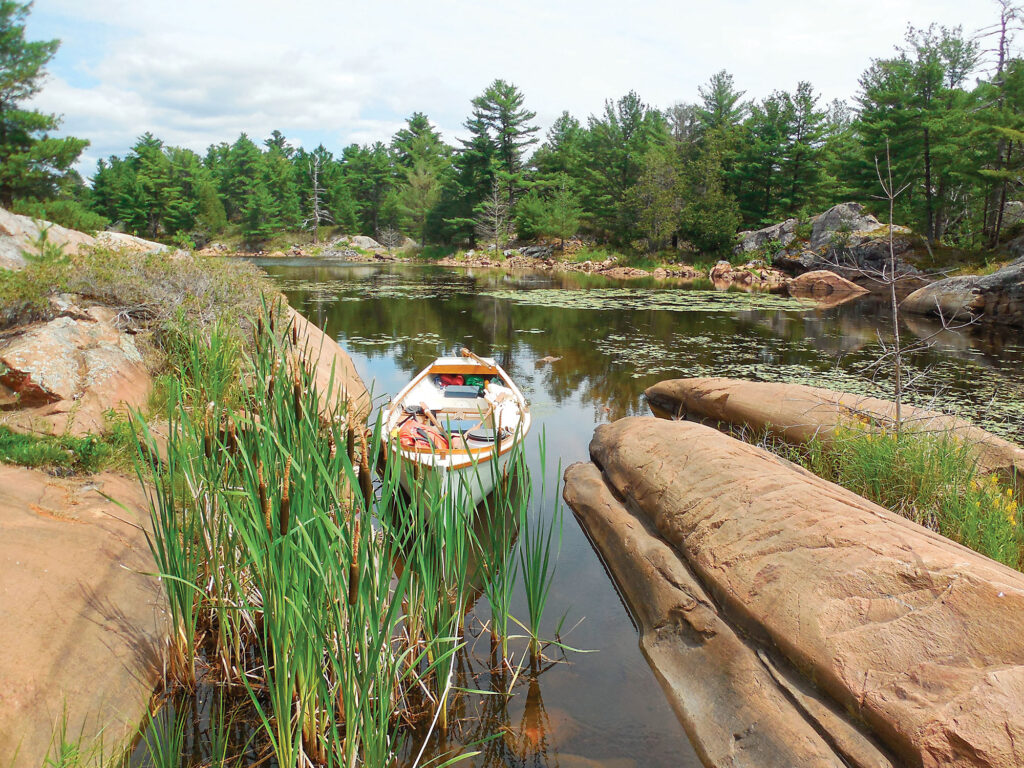
After a couple of days exploring inshore, we spent two days sailing back toward Killarney through wide-open waters, zigzagging offshore in a long series of lopsided tacks to make westward progress against the prevailing winds: past Hen Island, past The Chickens, past Grondine Point and Beaverstone Bay.
By now, Jay was an old hand at the tiller, handling FOGG with an ease born of long practice. We made our last camp on Hawk Island, carrying our tents to a high ledge just below the summit, leaving the boat tied to shore at a quiet corner of the beach far below. The setting sun made sharp silhouettes of the Fox Islands, with the rugged La Cloche Mountains forming a jagged skyline on the mainland beyond.
I sat on the summit of Hawk Island well into the night, long after daylight had faded from the sky to reveal the stars overhead, one after another. From where I sat, I could see FOGG resting quietly at anchor in the quiet water of the bay far below, the pale green hull barely visible in the light of a waning moon. Jay sat nearby with his guitar, working his way through a Jackson Browne song, in no hurry to crawl into his tent.
In the morning, we’d have 10 miles of sailing to reach Killarney—10 miles away, and a different world entirely. I wasn’t sure if either of us was ready to return.
Tom Pamperin is a writer, teacher, small-boat sailor and occasional boatbuilder based in the Upper Midwest. He writes regularly about wooden-boat building and sailing. His 2014 book, Jagular Goes Everywhere: (mis)Adventures in a $300 Sailboat, received an honorable mention for the Council for Wisconsin Writers’ Blei/Derleth Nonfiction Book Award.

